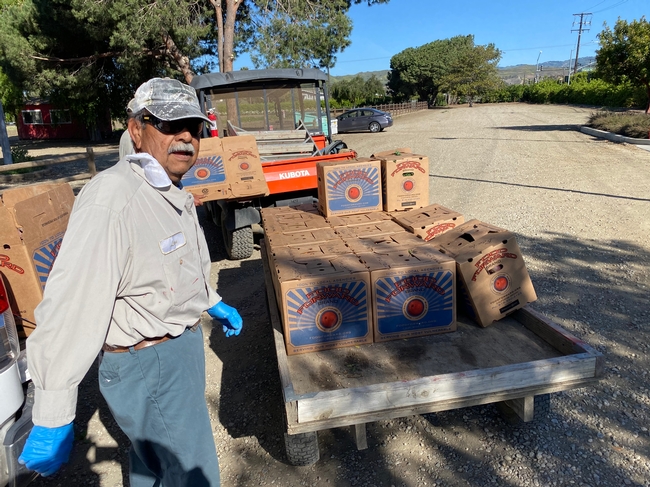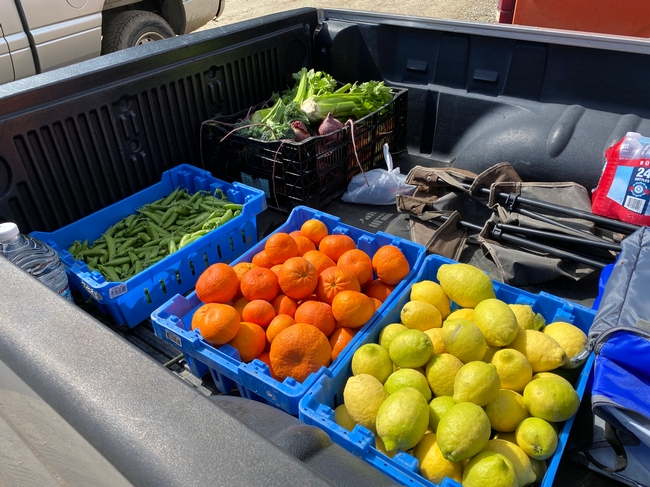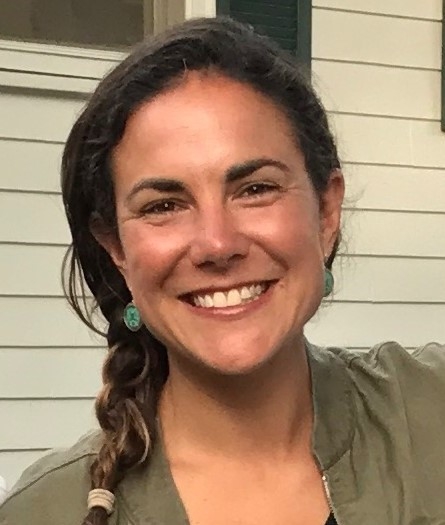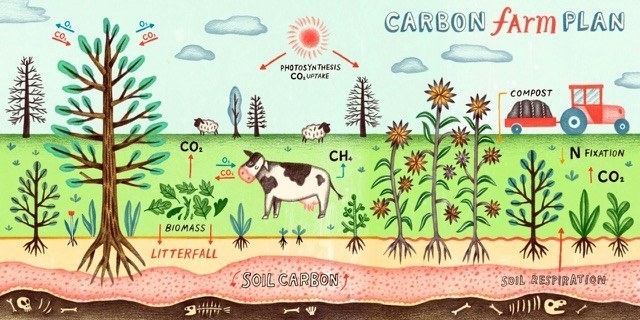
Posts Tagged: farm
UC HAREC Donates Fruits and Vegetables to Food Forward and Ventura Schools
Nearly two tons of fruit and vegetables grown at UC's Hansen Agricultural Research and Extension Center (HAREC) in Santa Paula have been donated to Food Forward and the Ventura Unified School District (VUSD), destined for children and families.
Some of the vegetables – planted by volunteers and farm staff - became available when UC HAREC's farm field trips were canceled due to COVID-19. Other vegetables were harvested from the student farm located at HAREC, a partnership with VUSD and the city of Ventura. Kale and lettuce at the student farm were planted by youth from DATA and Montalvo schools.
Every fall and spring, volunteers from the UC Master Gardener program propagate seedlings for schools, bundling them into variety packs of vegetables and herbs, which are given to schools with gardens. Because of COVID-19, plants were given to schools for direct distribution to families. Ventura Unified School District staff partnering in this effort include Kara Muniz, Director of Food and Nutrition Services; Ashely Parrish Decker, Nutrition Educator, who runs the Student Farm; and Alise Echles, RDN.
Additional fruit and vegetables were harvested from HAREC's citrus demonstration area, the site's educational gardens and the farm grounds.

UCCE's education program manager Susana Bruzzone-Miller said, “We are saddened that spring field trip season is cancelled and miss the sound of children delighting in harvesting, sometimes for the very first time. But, it warms my heart that our field trip garden can help feed so many families in need.”
John Antongiovanni, farm manager, worked with the farm staff to organize the harvest. He said, “Working together during this difficult time is very rewarding.”
Food Forward is a gleaning organization that helps residents turn the surplus produce grown on their property into a nutritious food source for local communities. Rick Nahmias, founder and executive director, indicated that the Food Forward Backyard Harvest team remains active, and may be reached via phone at 805.630.2728 or email.

IMG 20200420 153035966 HDR
Farming For Carbon
The Nuts and Bolts of Carbon Farming
I recently attended a Carbon Farm Plan Training hosting by Restoration Oaks Ranch, the Cachuma Resource Conservation District, and the Carbon Cycle Institute. I had heard about carbon farm plans and understood the concept, but attending this training gave me a much greater appreciation of what the nitty gritty details of creating one of these plans entails.
In a nutshell, a carbon farm plan takes a look at your farm from a carbon cycling perspective. The management practices that take place on the landscape influence the ins and outs of carbon moving through the system. Land management can push the meter towards increasing carbon into the system or releasing it out of the system. Developing a carbon farm plan creates a blueprint of management practices that lead to a net gain of carbon into the land system.
Agriculture is the one sector that has the ability to change from a net carbon emitter to a net carbon sequesterer. Common agricultural practices such as over-grazing, tilling the soil, over application of chemical fertilizers and pesticides, and mismanaged irrigation can result in carbon emissions, contributing to climate change. Removing carbon through harvesting crops without adequate replacement further depletes the carbon content of the soil. Carbon farming relies on plants doing the thing they do best, photosynthesizing, and maximizes the carbon cycle to result in a net gain of soil carbon. In this way, carbon farming improves the rate that carbon dioxide is removed from the atmosphere and converted to soil carbon or plant tissues, allowing agriculture to act as a net carbon sink. This process builds soil organic matter, which then increases water infiltration, enhances water-holding capacity, improves soil structure, and promotes soil microbiota diversity.
A Carbon Farm Plan is a long-term document created through a process modeled after the Natural Resource Conservation Service (NRCS) Conservation Plan. Local Resource Conservation Districts (RCDs) and agricultural support organizations (such as UC Cooperative Extension) provide the planning support to individual farmers and ranchers when creating a Carbon Farm Plan. The process begins with taking an overall inventory of natural resource conditions on the farm or ranch and generating a list of opportunities for enhanced carbon storage. The list of potential practices are refined based on the management goals of the farmer or rancher. Next, the carbon benefit potential for each practice is quantified using a set of online tools (COMET-Planner and COMET-Farm) developed by Colorado State University, NRCS, Carbon Cycle Institute, and the Marin Carbon Project. Once the list of practices are identified, prioritized, and quantified, a document is generated that lays out a plan of implementation based on funding sources and technical assistance.

What practices might you want to include in a Carbon Farm Plan? The NRCS has described many conservation practices that promote soil carbon sequestration and reduce greenhouse gas emissions. Some of these include:
- Cover cropping
- Compost application
- Reduced till or no till
- Multi-story cropping
- Windbreak and shelterbelt establishment
- Silvopasture establishment
- Forage and biomass planting
- Nutrient management
- Range planting
- Hedgerow planting
- Mulch application
A Carbon Farm Plan creates a road map for managing agricultural and working lands through a carbon lens. However, it also provides a working framework to address many ecosystem co-benefits that affect viability of agriculture in a changing climate. Improvements to soil health increase water holding capacity, soil stability and structural integrity, and decreases nutrient and water runoff. In addition, planting herbaceous and woody plants can sequester carbon while improving pollinator habitat. These practices influence the carbon cycle, but more broadly help agriculture build resiliency to drought, water inconsistencies, and temperature variability as the climate changes.
Let's get (carbon) farming!

Climate smart agriculture encompasses management practices that increase soil carbon sequestration, reduce greenhouse gas emissions, improve yields and efficiencies, and promotes climate resilience. The California Department of Food and Agriculture (CDFA) supports three funding opportunities in climate smart agriculture: the Healthy Soils Program, the State Water Efficiency & Enhancement Program, and the Alternative Manure Management Program.
In a collaborative partnership, CDFA and UC Agriculture and Natural Resources have teamed up to support 10 community education specialists throughout the state to provide technical assistance and outreach for the climate smart agriculture programs. As one of these technical assistance providers, my role is to promote and support the adoption of these programs in Ventura County. If you are interested in working with me, please contact me at amrowe@ucanr.edu.
USDA Fire Loss Programs
USDA's Farm Service Agency (FSA) offers disaster assistance and low-interest loan programs to assist agricultural producers in their recovery efforts following wildfires or other qualifying natural disasters. Available programs and loans include:
- Non-Insured Crop Disaster Assistance Program (NAP)
- - provides financial assistance to producers of non-insurable crops when low yields, loss of inventory, or prevented planting occur due to natural disasters including excessive wind and qualifying drought (includes native grass for grazing). Eligible producers must have purchased NAP coverage for 2017 crops. A notice of loss must be filed within 15 calendar days of when the loss is apparent or 15 calendar days after the normal harvest date.
- Livestock Indemnity Program (LIP)
- - offers payments to eligible producers for livestock death losses in excess of normal mortality due to adverse weather. Eligible losses may include those determined by FSA to have been caused by hurricanes, floods, blizzards, wildfires, tropical storms, tornados lightning, extreme heat, and extreme cold. Producers will be required to provide verifiable documentation of death losses resulting from an eligible adverse weather event and must submit a notice of loss to their local FSA office within 30 calendar days of when the loss of livestock is apparent.
- Tree Assistance Program (TAP)
- – provides assistance to eligible orchardists and nursery tree growers for qualifying tree, shrub and vine losses due to natural disasters including excessive wind and qualifying drought.
- Emergency Assistance for Livestock, Honeybees, and Farm-Raised Fish Program (ELAP)
- - provides emergency relief for losses due to feed or water shortages, disease, adverse weather, or other conditions, which are not adequately addressed by other disaster programs. ELAP covers physically damaged or destroyed livestock feed that was purchased or mechanically harvested forage or feedstuffs intended for use as feed for the producer's eligible livestock. In order to be considered eligible, harvested forage must be baled; forage that is only cut, raked or windrowed is not eligible. ELAP also covers up to 150 lost grazing days in instances when a producer has been forced to remove livestock from a grazing pasture due to wildfire and for beekeepers, ELAP covers beehive losses (the physical structure) in instances where the hive has been destroyed by a natural disaster including flooding, high winds and tornadoes. Producers must submit a notice of loss to their local FSA office within 30 calendar days of when the loss is apparent.
- Emergency Loan Program
- – available to producers with agriculture operations located in a county under a primary or contiguous Presidential or Secretarial disaster designation. These low interest loans help producers recover from production and physical losses.
- Emergency Conservation Program (ECP)
- - provides emergency funding for farmers and ranchers to rehabilitate land severely damaged by natural disasters; includes fence loss.
- HayNet
- - is an Internet-based Hay and Grazing Net Ad Service allowing farmers and ranchers to share ‘Need Hay' ads and ‘Have Hay' ads online. Farmers also can use another feature to post advertisements for grazing land, specifically ads announcing the availability of grazing land or ads requesting a need for land to graze. www.fsa.usda.gov/haynet.
www.fsa.usda.gov/disaster
For more information on these programs, visit FSA online at www.fsa.usda.gov.
To find a local FSA office near you, visit
http://offices.usda.gov.
USDA is an equal opportunity lender, provider and employer.

fire NRCS damage
California Farm to School Network meets at HAREC
Farm to school enriches the connection communities have with fresh, healthy food and local food producers by changing food purchasing and education practices at schools Pre-K to high school. Although Farm to school programs may vary in each community...

Jose De Soto, HAREC Academic Coordinator welcomes group.

Sandy Curwood, Director of Child Nutrition Services, ConejoValley Unified School District

farmers, educators and food procurement networking
Food Corps Recruits Locally
In the spirit of eating and sourcing local—Food Corps seeks to recruit a homegrown service member to work with Ventura Unified School District (VUSD) for the 2015-2016 school year. Food Corps is a nationwide team of AmeriCorps leaders who connect...
Food Corps Informational flyer



